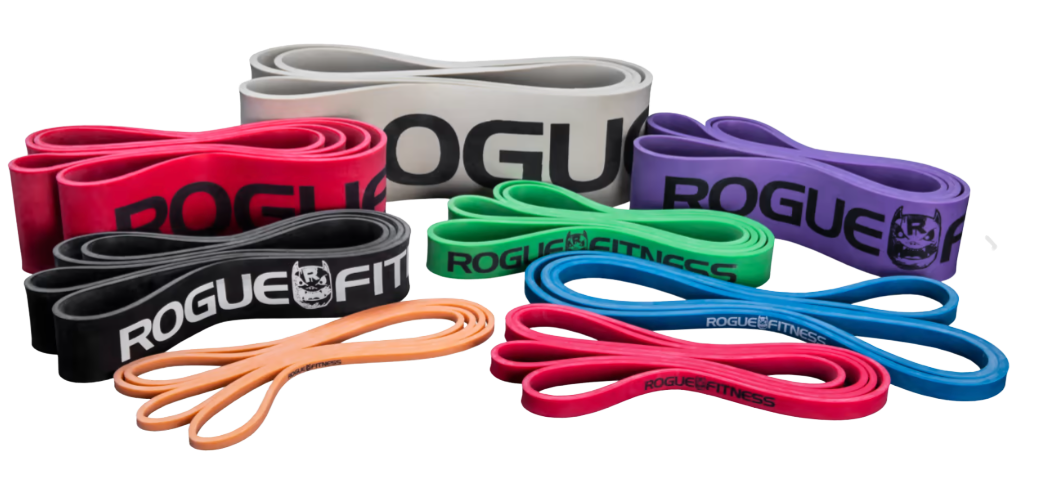Best Shoulder Band Stretches for Shoulder Pain
Shoulder band stretches can help strengthen and improve your shoulders’ overall function.
Suppose you are recovering from any shoulder injury, for example, a rotator cuff tear or shoulder surgery. In that case, you should read on to discover various shoulder mobility exercises with bands that will help your recovery.
Your shoulders are some of the most complex joints in your body. Their complexity means that they are susceptible to injury. Shoulder band stretches can help your recovery from shoulder pain and help strengthen your shoulder joint to prevent further damage.
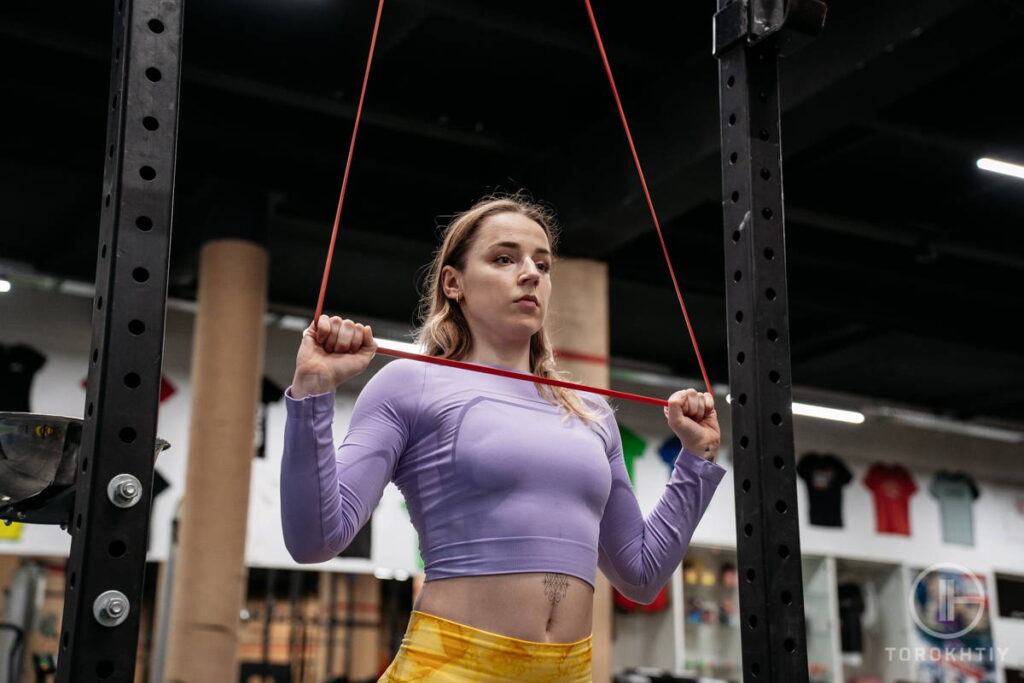
Shoulder Band Stretches Benefits
There are numerous reasons and benefits why you should use resistance bands in your training and recovery. Some of the benefits include:
1. Safe and Low Impact
Your shoulders are complex joints that are prone to injury.
Using a resistance band can help build strength and stability while also helping to improve mobility in your shoulders with little risk of injury.
Resistance bands allow you to apply resistance at any angle without gravity. This will enable you to focus on specific areas in various angles of rotation.
2. Can Be Modified for Personal Needs
Resistance bands come in a range of resistance levels, but even if you only own one or two, you can still adjust the resistance by adjusting the length.
This means that you can modify each stretch or exercise to suit your own needs.
3. Portable, Inexpensive, and Simple to Use
You won’t have to break the bank to purchase a set of resistance bands, yet they offer so many variations and benefits you should consider adding them to your gym kit.
They can help improve flexibility and help to correct muscle imbalances. If you are recovering from injury or surgery, they can also help your recovery.
As they are light and take up very little space, they can be packed away easily. So even if you are going on holiday, there is no reason not to pack them so you can continue your recovery while away from home.
4. Perfect for Stretching and Mobility
Your flexibility and range of motion can often limit your ability to stretch before and after training.
Using a resistance band can help extend your reach and help provide additional pressure while attempting specific stretches. For example, while doing a lying hamstring stretch.
Top Exercises For Shoulder Stretch
1. Front Raise
The front raise is one of the simplest shoulder stretches with bands. It is conducive for warming up the front and side deltoids and your serratus anterior and bicep muscles.
This exercise has also been shown to improve the stability and mobility of your shoulders.
To perform this exercise use the following method:
- While standing straight with your legs knee width apart, place a resistance band under your feet while holding the ends with your hands.
- Making sure your knees are slightly bent, slowly raise the bands simultaneously until they reach shoulder height. Then return to the starting position.
If you find this exercise too easy, it is possible to increase the resistance by standing on more of the band or raising the band higher.
While performing this exercise, try to avoid using your momentum while raising your hands and to keep your core engaged throughout.
2. Single-Arm Side Raise
This is one of the best resistance band stretches for shoulders, working the medial deltoid.
It is shown to help improve shoulder mobility while also helping to engage your core and upper back muscles.
You should use the following method to perform this exercise:
- Hold the resistance band with one hand while standing on the other end of the band. Adjust the length of the band to change the resistance; typically, you will use less resistance than the front raise.
- Face your palm inwards, with your elbow slightly bent, and raise your arm until it is level with your shoulder.
- Hold at the top before returning to the start position.
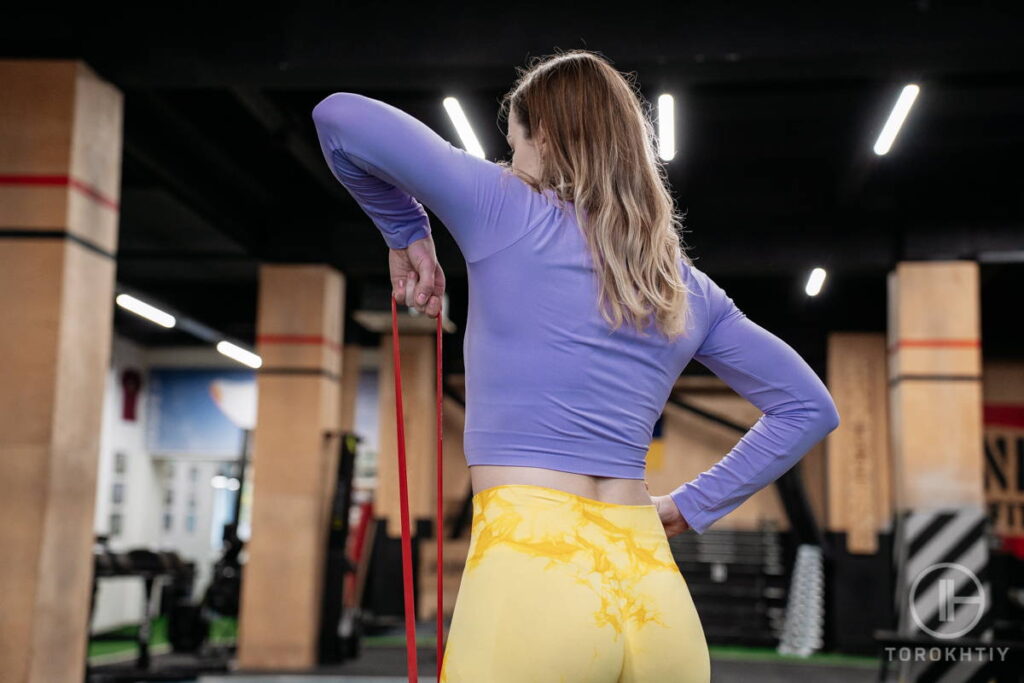
3. Reverse Fly
If you do a lot of forward-bending movements in work, this resistance band stretch would be beneficial for strengthening your shoulders, upper back, and upper arms. It would also be good for your posture.
You can perform the reverse fly using this method:
- Start by standing in the middle of the band.
- Next, cross the end of the band into the opposite hand so that it crosses in front of your legs.
- With your knees slightly bent throughout the exercise, hinge at the hips while bending forward.
- Pull the band up and out so that your hands reach chest height. You should feel your shoulder blades move closer together.
- Hold this position for a second before returning to the starting position.
4. Pull-Apart
Our next resistance band shoulder stretch is the pull-apart, an exercise that targets the backs of your shoulders.
The benefit of this particular resistance band shoulder stretch is improved shoulder stability and improved posture.
It can be performed the following way:
- Start by holding a resistance band between both hands. The less space between hands, the more resistance will be provided.
- With your back straight and elbows slightly bent, pull the band back with your hands so that your shoulder blades move closer together.
- Hold this position so you can feel your shoulders and chest engaged, then slowly release back to the starting position.
5. External Rotation
If you spend your days at the office hunched over a computer, you will surely see the benefit of this resistance band shoulder stretch.
This particular exercise helps with shoulder mobility, plus helps with maintaining good posture, which is incredibly important to avoid back problems.
You can perform this stretch using the following method:
- Start by attaching a resistance band to a fixed object at belly-button height.
- While standing shoulder width apart and at a right angle to the band, hold onto the band using your outside arm.
- With your arm stuck to your side, rotate your forearm out before returning to the starting position.
- Swap sides and complete the same number of repetitions with the opposite arm.
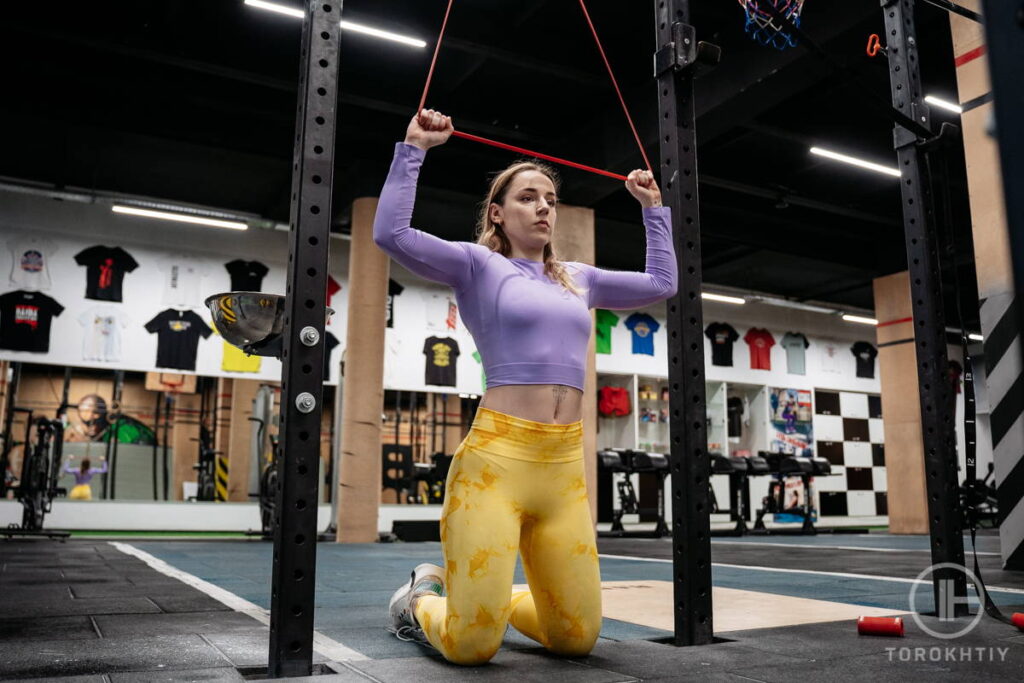
6. Internal Rotation
This is one of the better resistance band rotator cuff exercises available and is undoubtedly one you should be trying if you are unfortunate enough to suffer this painful injury.
This exercise is the opposite of the external rotation exercise and can be performed using this method:
- Attach the band to a fixed object at belly-button height.
- With your legs shoulder width apart and at a right angle to the band, rotate the band towards your belly before returning to the starting position.
7. Standing Row
Our final stretch is one of the best rotator cuff resistance band exercises.
The standing row helps to stretch and strengthen the middle and lower trapezii muscles.
It can be performed in the following way:
- Tie two ends of a resistance band together and attach the loop to a firm and stable object.
- Keep your elbows bent at your side, and pull your elbows back while holding the band close to your side.
- Hold in this position for a second before returning to the starting position.
8. Overhead Mobility Training
If you struggle with mobility and are experiencing shoulder and other joint issues, you should check Overhead Mobility Training.
This course was designed by Oleksiy Torokhtiy, who has been involved with Olympic weightlifting for over 20 years.
Working alongside his colleague Zina Bondarenko, a sports rehabilitation therapist, Oleksiy has designed a six-week program that will improve your mobility, enabling you to see improvements in your Olympic lifts.
The course has eighteen 30-minute workouts, with 120 videos to help develop joint strength while in the overhead position and help increase your confidence while weightlifting.
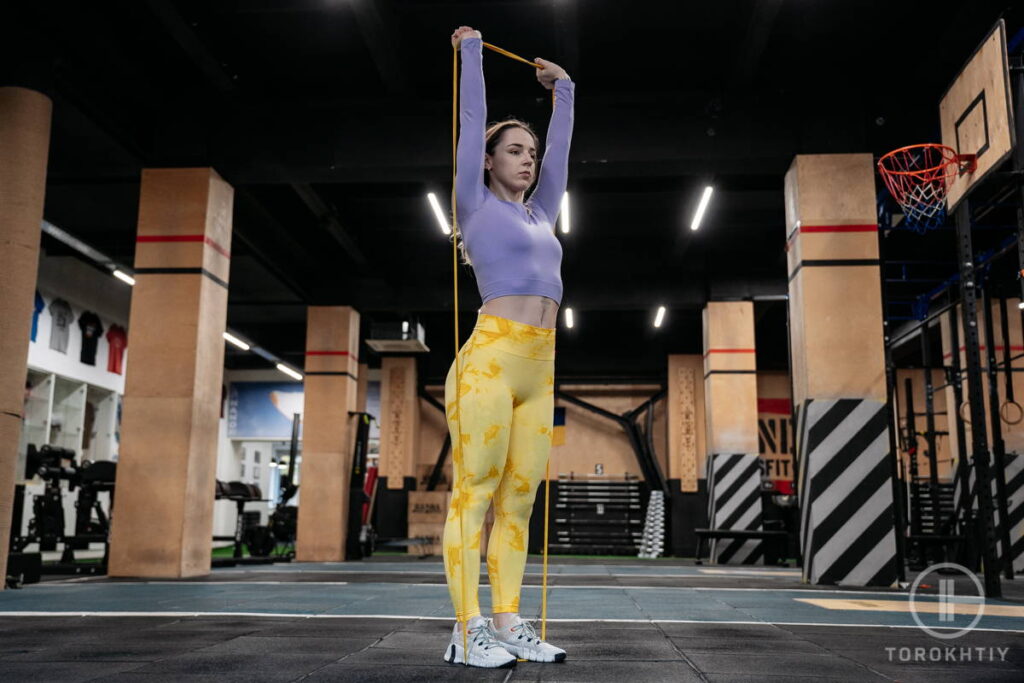
How to Pick Resistance Bands for Shoulder Stretches?
Before picking resistance bands, you must decide what you will use them for.
Are you looking to build strength and muscle, or are you planning shoulder rehab exercises with bands?
Whatever the reasons, there are a few different types of resistance bands, all with their own benefits and drawbacks.
- Resistance Bands with Handles – This variety is usually used to build muscle and strength. They typically come with sturdy handles and several different bands with varying degrees of resistance. You would use these bands to perform exercises you would usually perform with free weights or machines at the gym.
- Therapy Flat Resistance Bands – You will often see this variety if you have ever had to visit a physical therapist. The bands themselves are wide and flat, with varying levels of resistance. They are easily wrapped around your hands or cut to adjust the size.
- Loop Bands – This variety is similar to the therapy bands but are smaller and form a closed loop. These bands are often found in gyms, where they are used to build strength in the legs and glutes.
- Leg & Arm Tube Resistance Bands – These are muscle-specific and can only be used for the muscle group they are designed for. For example, those with ankle cuffs can only be used on your legs.
- Power & Mobility Bands – These heavy-duty resistance bands provide the most resistance of all varieties. They form a loop and are often used by those in the gym, sometimes to help provide additional resistance when performing specific exercises, for assistance when performing pull-ups, and for stretching and mobility issues.
Once you have decided why you want to buy resistance bands, there are a few more things to consider.
Firstly, if you are a beginner, you would likely want to start with a lighter resistance band; then, as you progress, you should look to use bands with more resistance.
It would be best if you got a range of resistance bands offering differing levels of resistance so that you can move to a different band when you get stronger.
The bands come in different colors to represent their resistance; while this is handy for keeping an eye on your progress, you should be aware that the colors will vary between brands and products.
It would be best if you always aimed to buy the best quality bands; you most certainly want to avoid purchasing a band that will become sticky or snap while performing your stretches.
Typically a thicker resistance band will be more durable than a thinner one. Before use, you should always check your bands over for wear and tear, and if you notice any damage, it will be time to invest in some new ones.
When choosing resistance bands for shoulder rehab, you should consider the materials they are made from.
Most bands are made from an elastic fabric or a rubber latex; choosing it will come down to whichever you prefer.
The fabric bands are more durable and comfortable, especially over your lower legs. Latex bands are stretchier but tend to pull on your skin and hair when used.
Finally, when picking a resistance band, consider what accessories it comes with or are suitable to use alongside.
Certain resistance bands have handles, door attachments, or ankle cuffs. Ask yourself whether you need any of these additional accessories; if you are a beginner, you should aim to keep things simple.
The resistance bands we recommend are the Rogue Echo Resistance Bands.
These bands are 41″ in length and come in various colors; they offer resistance ranging from 15 lbs to 200 lbs. Perfect for adding additional resistance to your squats or bench presses.
FAQ
How Do You Stretch Your Rotator Cuff With a Band?
Resistance bands are used for strengthening the muscles surrounding the rotator cuff. To stretch your rotator cuff, you would use the crossover arm stretch, amongst others.
Can Resistance Bands Help Shoulder Pain?
Resistance band shoulder stretches not only help reduce shoulder pain but also help strengthen your shoulders to prevent injury in the future.
Conclusion: Can Resistance Bands Aid Shoulder Recovery?
Resistance bands are simple to use and affordable to buy, plus they offer a range of benefits.
Whether you want to use them to increase muscle and strength, or you want to use them to improve flexibility or to aid in your recovery, a set of resistance bands would be an excellent investment.
If you have purchased some resistance bands or have any questions about them, please leave your comments below.
Also Read:
- Bench Press With Resistance Bands
- Assisted Pull Ups With Resistance Bands
- Resistance Band Squats
- Resistance Band Tricep Workout
- Resistance Band Chest Exercises
- Resistance Bands vs Weights
- Resistance Band Lat Pull Down
- Best Blood Flow Restriction Bands
- Best Resistance Bands
- Benefits of Resistance Band Training
References:
- Effects of training with elastic resistance versus conventional resistance on muscular strength: A systematic review and meta-analysis // National Library of Medicine:
https://www.ncbi.nlm.nih.gov/pmc/articles/PMC6383082/ - Effectiveness of resistance exercise using elastic bands on flexibility and balance among the elderly people living in the community: a systematic review and meta-analysis // National Library of Medicine: https://www.ncbi.nlm.nih.gov/pmc/articles/PMC5599848/
- Effects of specific muscle imbalance improvement training on the balance ability in elite fencers // National Library of Medicine: https://www.ncbi.nlm.nih.gov/pmc/articles/PMC4483447/
Why Trust Us?
With over 20 years in Olympic Weightlifting, our team does its best to provide the audience with ultimate support and meet the needs and requirements of advanced athletes and professional lifters, as well as people who strive to open new opportunities and develop their physical capabilities with us.
By trusting the recommendations of our certified experts in coaching, nutrition, dietology, and sports training programming, as well as scientific consultants, and physiotherapists, we provide you with thorough, well-considered, and scientifically proven content. All the information given in the articles concerning workout programming, separate exercises, and athletic performance, in general, is based on verified data. We ensure that you can rely on our professionals’ pieces of advice and recommendations that can be treated as personalized ones which will benefit you and fully meet your needs.
The product testing process is described in more detail here
Author: Ihor Shymechko
Pro Olympic Weightlifter, Coach
Best Results: Snatch – 208 kg,
C&J – 240 kg
Ihor has been a professional weightlifter since 1996, boasting over two decades of competition experience. His notable achievements include clinching the European Championship in 2009 and securing a silver medal in the 105kg division at the Senior World Championships in 2011. Ihor represented his country in the 2008, 2012, and 2016 Summer Olympics. After retiring from competitive weightlifting, he transitioned to coaching, leveraging his vast experience to guide athletes who now compete on both national and international stages.

